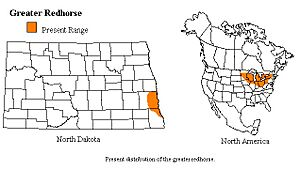Greater redhorse facts for kids
Quick facts for kids Greater redhorse |
|
|---|---|
 |
|
| Greater Redhorse (Moxostoma valenciennesi) | |
| Conservation status | |
| Scientific classification | |
| Synonyms | |
|
The greater redhorse (Moxostoma valenciennesi) is a type of freshwater fish. It lives in rivers and lakes in northeastern North America. This fish is the largest member of its family, called Moxostoma. It can grow up to 80 centimeters (about 31.5 inches) long. Greater redhorse fish can also live for a long time, sometimes even up to 27 years!
Contents
Where the Greater Redhorse Lives
The greater redhorse fish lives in the northcentral and northeastern United States. You can also find them in Ontario and Quebec in Canada. They usually live in clear rivers that move fairly fast. They can also be found in both shallow and deep parts of some lakes. These fish need very clean water to survive. They cannot live in water that is even a little bit polluted. This means they are a good sign of healthy water.
What the Greater Redhorse Looks Like
The greater redhorse is the biggest fish in its group. On average, it is about 46 centimeters (18 inches) long and weighs around 2 kilograms (4.4 pounds). The largest ones can reach 80 centimeters (31.5 inches) and weigh up to 5.9 kilograms (13 pounds). This fish has small eyes compared to its large, round head. On each side of its body, it has reddish-gold pectoral fins (like arms) and pelvic fins (like legs).
The back part of its dorsal fin (the fin on its back) changes shape as it grows. It is slightly curved inward when young and slightly curved outward when it's an adult. Their tail fins are only slightly notched. This is a common feature for fish that swim slowly and feed on the bottom. The easiest way to spot a greater redhorse is by its bright, rusty-red tail fin. It also has rows of black spots along its sides and back.
What the Greater Redhorse Eats
The greater redhorse is a bottom-feeder. This means its mouth opens on the underside of its head, pointing downwards. It eats different small creatures that live on the bottom of rivers and lakes. These include tiny crustaceans, water insects and their young, and decaying plant and animal bits (called detritus). They also eat snails and algae.
Reproduction and Life Cycle
Greater redhorse fish start to lay their eggs in May or June. First, they find a spot in water that moves at a medium speed. Here, they build their nests using gravel and sand. Once the male fish have set up their areas, a female will visit two males at a time. The two males will then surround the female. They perform a shaking motion, which releases both the sperm and the eggs.
After the eggs are buried, the parent fish leave. They do not provide any more care for their young. The eggs hatch in about six to eight days if the water temperature is around 19 degrees Celsius (66 degrees Fahrenheit). How fast these fish grow can be different depending on where they live. Greater redhorse fish take several years to become old enough to reproduce. They often live for more than 20 years, making them one of the longest-living redhorse species.
Why the Greater Redhorse is Important to Humans
The greater redhorse fish is facing threats across the areas where it lives. In the past, it was not a popular fish for sport fishing. However, this long-lived fish, which takes a long time to mature, is now being harmed by unregulated bowfishing. In bowfishing, many fish are shot for sport and then often wasted. The number of fish caught this way can be much higher than what is caught by commercial fishing.
Because of this, the greater redhorse needs help with conservation and management. It is especially important to stop the waste that happens with bowfishing. The greater redhorse is a prey species, meaning other animals eat it. This makes it a very important part of the ecosystems where it lives. Since these fish are greatly affected by pollution, their declining numbers might be due to people not being careful about where they dispose of waste.
The IGFA (International Game Fish Association) world record for the largest greater redhorse caught was 12 pounds 7 ounces. This fish was caught from the Sauk River in Minnesota in 2005. More and more, people who fish with a rod and line are also trying to catch the greater redhorse.



